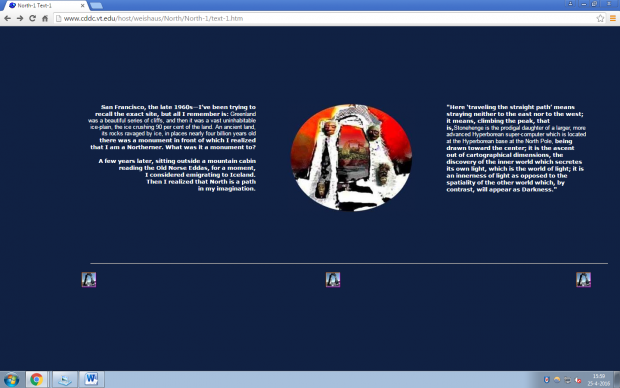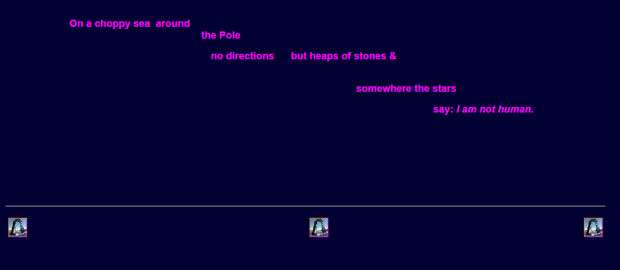The Way North
"The Way North" is a Digital Literary Art project that works its way through history, myths and motifs with regards to Inuit folkways and the disasters of global climate change.
Artist Statement
Edited from an interview with Edward Pirot on "The Way North" . . .
The challenge of this project, as with several others, was to take an important, if not crucial, subject (in this case, the warming of the Arctic and the destruction of a way of life as symbolic of what's happening, and will happen, globally) and make a piece of Digital Literary Art that would be informative while advancing the medium's aesthetic possibilities
I always do research for a several months before beginning to write and design a project, so that by the time I began I already had a fairly large notebook from which to draw. But the research continued throughout the one and a half years, and, as usual, lead me in unexpected directions.
The original plan called for 35 screens, because that boxes the northern half of the compass. But I stopped at twenty-five and redesigned the contents page, not only because other work was beginning to develop, but because I felt the project was getting too large to expect people to consider the screens in any depth, and the depth, or density, of texts and images is always my prime consideration. Duration is to Digital Literary Art what size of canvas is to a painting. Thus, there are five screens linked to each button on the contents page, each thread a loose theme.
As to the level of detail I began with, that developed as I went along. But I did consciously balance the various inputs. I hope that part of the pleasure of viewing "The Way North" is not knowing what to expect on the next screen, whether it be a sound, animation, or a hidden link. Except for the excerpts from Glenn Gould's radio play, "The Idea of North," sounds were found on the Internet when needed, edited and sometimes collaged.
The textual splicing you speak of, I call "invaginations." My idea, which dates back to the early 1990s, was to have quotes within quotes, each in a smaller font, until they disappeared, and then returned back out, font by font, finally to continue the original sentence. Sort of like a whirlpool of information enveloped in the middle of an idea. But this didn't work because, functionally, it became too complex. So now I usually use a single interruption. Invaginations bug some people; but disruption of the text’s smooth line of flight is the plan, and also to inject fragments from the canon directly into the body of the text.
I don't remember exactly how invaginations came about. They just sort of evolved. I suspect my reading of Gregory Ulmer's essay, "The Object of Post-Criticism," had something to do with it. Probably, also, Edmund Jabes' poetry, which I was enthusiastically reading during the mid-1980s. Barthes, Derrida, Deleuze, all contributed. Intellectually, that was an exciting time! Then the availability of wordprocessing programs finally made the trope technically viable.
I try to use the simplest digital tools that still give me the ability to carry out an aesthetically complex agenda. Just like I incorporate iterant voices into my writing, I move a project through several ancillary programs, each supplying its range of code, which builds into a complexity of words, images, and sometimes sounds. I think you're right that I don't want to be too heavily indebted to the technology because it can lead me away from the purity of the creative act. For example, hand-coding would be a waste of time for me. But we are all learning from each other's approach to this still nascent medium.
(Source: 2008 ELO Media Arts show)




